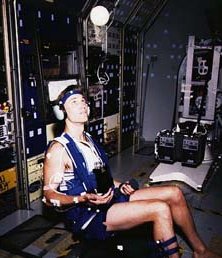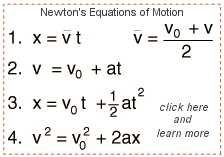|
Playing catch looks easy, but there's more
to it than meets the eye. A ball-catching experiment in space has
revealed that human brains have a built-in model of gravity.
by Karen Miller
Playing catch is easy. Kids and even
their parents can do it. Keep your eyes on the ball and - if you
don't think too hard - your hand will grab it in mid-air. It's simple,
really.
Or is it? In fact, playing
catch is more complicated than it appears.
Just before the ball
arrives, your hand twists slightly. The muscles tense, so your hand
isn't knocked away by the force of the blow. The timing is surprisingly
exact: the muscles tighten exactly one-tenth of a second before
the ball's impact.
The brain prepares for the catch even
earlier. The hand moves only because the brain tells it to - and
it takes two tenths of a second for the brain's commands to travel
down to the hand. Such delays
require the brain to predict when the ball will arrive - a process
made more difficult because, due to gravity, the speed of a soaring
ball is always changing.
How does your brain do it?
According to neuroscientist
Joe McIntyre of the College de France, the brain is so accurate
because it contains an internal model of gravity. The brain, he
says, seems able to anticipate, calculate and compensate for gravitational
acceleration - naturally.
His conclusions, published
recently in the journal Nature Neuroscience, are based on
an innovative ball-catching experiment conducted in space: Astronauts
on board space shuttle Columbia caught balls released from a spring-loaded
canon. The balls moved with a constant speed as opposed to
a constant acceleration as they would on Earth. While the
astronauts were playing catch in this manner, infrared cameras tracked
the motions of their hands and arms, and electrodes measured the
electrical activity of their arm muscles.
McIntyre and colleagues designed the unusual experiment at the Centre National de
la Recherche Scientifique (CNRS) in France and at the Santa Lucia
Scientific Institute in Rome. It flew to space for a 17-day mission
in 1998, one of 26 life sciences experiments in the Neurolab payload.

Credit: National Photo Co. The Charleston as
an aid to the game. Created between 1920 and 1932. Prints
and Photographs Division, Library of Congress.
Basketball
players learn the Charleston in the hope it will help their
game. Does balancing on one leg offer conclusive proof as
to gravity on the brain? (Perhaps Not)
|
In flight, says McIntyre,
the astronauts were always able to catch the ball, but their timing
was a little bit "off." They reacted as if they expected the ball
to move faster than it did - in other words, as if gravity was "Earth-normal."
The astronauts' expectation
of gravity was surprisingly persistent. They continued to mis-anticipate
the ball's motion nearly fifteen days into the experiment - "although
we did begin to see some evidence of adaptation at that point, "
says McIntyre.
"The question is," he
said, "if you do anticipate gravity, then why?"
Astronauts orbiting Earth
clearly sense a change in acceleration: for example, the astronauts
themselves float. And they do adapt to weightlessness in many ways.
Motion sickness, for example, tends to disappear after two or three
days in space. Yet for nearly fifteen days, astronaut brains continued
to predict that balls would be accelerated as on Earth, even in
the face of contrary evidence.

[more]
An
astronaut prepares for the ball-catching experiment inside
the Neurolab trainer.
|
Such rigid, inflexible
behaviour supports the notion that the brain contains a built-in
model of gravity - like a specialized computer in our heads that
calculates acceleration.
There's other evidence,
too. For instance, says McIntyre, if you place an infant safely
on a glass table where he or she can see the floor below, the baby
will become fearful. He's not falling, yet he expects to fall -
without any prior experience of falling. "It doesn't take much to
elicit this response," he added. "It seems like a very robust, common
effect that we expect a downward acceleration."
Eventually the amount
of acceleration we anticipate can be changed from Earth-normal to
other values. To wit: By the 15th day of the Neurolab mission astronauts
on the shuttle were beginning to catch the ball better. The too-early
movement of the arm remained, but its amplitude grew smaller. At
the same time, the astronauts began to add in an additional arm
movement - one timed to occur just before the ball's impact.
When the astronauts repeated
the experiments on the ground, they all, said McIntyre, seemed surprised
at how fast the ball dropped. But they adjusted far more quickly
than they had in space. On Earth, if you're late with your response,
you miss the ball. Perhaps that forces you to learn more quickly,
he suggests.

Hyperphysics
Concepts
Are
Newton's equations of motion built-in to the human brain?
That's what the Neurolab ball-catching experiment aimed to
find out.
|
It's possible that the astronauts did
adapt to 0-g, and then readapted back to 1-g again. It's also possible
that the brain is able to learn and retain multiple models of acceleration.
In different situations, it might simply choose which one to apply.
That, in fact, is what McIntyre and his colleagues believe is going
on.
McIntyre's Neurolab experiment
was surely fun, but there's more at stake than fun and games.
Researchers hope that
understanding how astronauts adjust to the unexpected movements
of objects in space will improve mission safety. There are also
benefits to those of us on Earth: Such experiments, says McIntyre,
offer a unique way to explore the nervous system. Some kinds of
brain damage cause trouble with timing much like the astronauts
experienced. Unraveling how the nervous system works is an important
step in treating these kinds of problems.
Indeed, the human nervous
system remains a puzzle in many respects. Experiments like this
one show that at least some of the pieces may be found ... in space.
|
